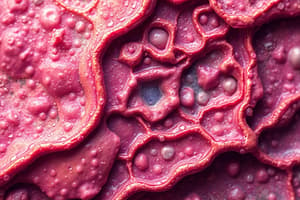Podcast
Questions and Answers
What is a primary function of epithelial tissue?
What is a primary function of epithelial tissue?
- Transportation of nutrients
- Support and connection of tissues
- Protection against bacterial infection (correct)
- Storage of fat
Which cell type is primarily responsible for producing fibers in fibrous connective tissue?
Which cell type is primarily responsible for producing fibers in fibrous connective tissue?
- Fibroblasts (correct)
- Chondrocytes
- Macrophages
- Adipocytes
Which type of connective tissue is primarily responsible for binding organs together?
Which type of connective tissue is primarily responsible for binding organs together?
- Fibrous connective tissue (correct)
- Cartilage
- Blood
- Adipose tissue
How do macrophages function within connective tissue?
How do macrophages function within connective tissue?
Which type of collagen fibers are tough and flexible, resisting stretching?
Which type of collagen fibers are tough and flexible, resisting stretching?
What role does adipose tissue serve in the body?
What role does adipose tissue serve in the body?
What is a function of ligaments within connective tissue?
What is a function of ligaments within connective tissue?
What is a tissue primarily defined as?
What is a tissue primarily defined as?
Which type of tissue forms the skeleton in the body?
Which type of tissue forms the skeleton in the body?
Which of the following is NOT a type of animal tissue?
Which of the following is NOT a type of animal tissue?
What is the main function of epithelial tissue?
What is the main function of epithelial tissue?
What type of epithelial tissue is characterized by multiple layers of cells?
What type of epithelial tissue is characterized by multiple layers of cells?
Which shape describes cuboidal epithelial cells?
Which shape describes cuboidal epithelial cells?
Where are simple squamous epithelial tissues primarily found?
Where are simple squamous epithelial tissues primarily found?
What is one of the main roles of cuboidal epithelial tissue?
What is one of the main roles of cuboidal epithelial tissue?
Which characteristic is unique to stratified epithelial tissues?
Which characteristic is unique to stratified epithelial tissues?
Flashcards
Epithelial Tissue
Epithelial Tissue
A tissue type that forms a protective barrier around organs and is involved in secretion and absorption.
Simple Epithelia
Simple Epithelia
A single layer of epithelial cells.
Stratified Epithelia
Stratified Epithelia
Multiple layers of epithelial cells.
Squamous Epithelial cells
Squamous Epithelial cells
Signup and view all the flashcards
Cuboidal Epithelial cells
Cuboidal Epithelial cells
Signup and view all the flashcards
Columnar Epithelial cells
Columnar Epithelial cells
Signup and view all the flashcards
Tissue
Tissue
Signup and view all the flashcards
Function of Epithelial Tissue
Function of Epithelial Tissue
Signup and view all the flashcards
Connective Tissue
Connective Tissue
Signup and view all the flashcards
Fibrous Connective Tissue
Fibrous Connective Tissue
Signup and view all the flashcards
What are fibroblasts?
What are fibroblasts?
Signup and view all the flashcards
Macrophages
Macrophages
Signup and view all the flashcards
Tendons
Tendons
Signup and view all the flashcards
Ligaments
Ligaments
Signup and view all the flashcards
Adipose Tissue
Adipose Tissue
Signup and view all the flashcards
Bone Tissue
Bone Tissue
Signup and view all the flashcards
Study Notes
Animal Tissues
- Animal tissues are groups of connected cells that work together to perform specific functions in an animal.
Types of Tissues
- Epithelial tissue: Covers body surfaces and lines body cavities.
- Muscle tissue: Enables movement.
- Nerve tissue: Facilitates communication.
- Connective tissue: Supports, connects, or separates different tissues and organs.
Epithelial Tissues
- General functions include acting as barriers between the external environment and internal organs, secretions, and protections.
- Two major types:
- Simple Epithelia: Single layer of cells.
- Stratified Epithelia: Multiple layers of cells (2-20 or more).
- Shapes:
- Squamous: Flat, thin cells.
- Cuboidal: Cube-shaped cells.
- Columnar: Column-shaped cells.
- Locations in the body vary depending on type and function.
- Simple squamous epithelium is found in capillaries and air sacs of the lungs (alveoli).
- Cuboidal epithelium are in kidney tubules and glands.
- Columnar epithelium lines the digestive tract.
Connective Tissues
- General functions include supporting, connecting, and separating tissues/organs; protecting, binding organs, and immune protection, and movement/heat production.
- Components:
- Cells: Fibroblasts, macrophages.
- Fibers: Collagenous, reticular, elastic.
- Ground substance.
- Types of fibrous connective tissue:
- Tendons: Attach muscles to bones.
- Ligaments: Connect bones at joints.
- Blood: Liquid connective tissue.
- Blood composition:
- Plasma (55%): Liquid matrix, mainly water, electrolytes, nutrients, gases, hormones, and enzymes.
- Formed elements (45%): Red blood cells (erythrocytes), white blood cells (leukocytes), and platelets (thrombocytes).
Muscle Tissues
- Skeletal muscle: Voluntary movements of the body, striated.
- Smooth muscle: Involuntary movements, found in walls of digestive tract, bladder, etc.; lacks striations.
- Cardiac muscle: Limited to the heart, striated cardiomyocytes.
Nervous Tissues
- Specialized for communication via electrical and chemical signals.
- Found in the brain and spinal cord.
- Composed of neurons (nerve cells) with dendrites, axons, and axon terminals, for transmitting signals.
Studying That Suits You
Use AI to generate personalized quizzes and flashcards to suit your learning preferences.




